St Patrick’s Church is located in Bolton, Greater Manchester, it chose Selectaglaze secondary glazing to silence the busses and bypassers for a quiet and peaceful space
After a meeting in 1853 about its development, architect Charles Holt was commissioned to build St Patrick’s Church which opened in 1861. The Gothic Revival style building is adjacent to another Grade II Listed building; the former Bolton County Grammar School which is now apartments.
 Drawing a great congregation from the local community, the diocese was concerned to hear of plans to build a new local transport hub and interchange on the opposing corner to the church, which formed part of the council’s masterplan to create an Innovation Zone to attract more professionals to the area, boosting the local economy.
Drawing a great congregation from the local community, the diocese was concerned to hear of plans to build a new local transport hub and interchange on the opposing corner to the church, which formed part of the council’s masterplan to create an Innovation Zone to attract more professionals to the area, boosting the local economy.
With plans to entice more visitors to Bolton, transport infrastructure into and around the city needed to be enhanced. In 2010 a consultation was launched regarding the re-siting and construction of Trinity Interchange, nestled between Bolton Train Station and St Patrick’s.
The plans included the erection of an acoustic wall to provide a buffer for the church from the low-frequency noise of the stationary busses (70-80dB). Unconvinced this would suffice; experts were brought in to provide further advice.
The St Patrick’s Church commission proposed an alternative means, by way of acoustic screens fitted externally to the church windows. Architects Greengaugh and Williams were employed to design a suitable solution and after some research, suggested that internal secondary glazing would provide the most effective solution. Fenestral, partner of Selectaglaze for over 20 years, was contacted and discussions on suitable treatments began, as well as how to approach the planning committee to submit the suggested change of plans.
Proposed secondary glazing accepted
Discreet designs were worked up. Reduction of the external noise was high priority but so was ensuring the configurations allowed access to the primary windows for cleaning and maintenance. The 4 clerestory windows were approximately 3m (h) x 1.2m (w) so Series 41 double side hung casements were transom coupled to Series 46 fixed lights.
However, the chancery window at 4.3m (h) x 3m (w) took a bit more thought to ensure that the sightlines were followed. Four different units were used: Series 80 3-pane horizontal slider was transom coupled to three Series 41 mullion coupled curved casements above.
Despite having deep reveals, which lent themselves well to the standard fixing method and deep cavity for noise reduction, it was a difficult installation and great attention to detail was needed while fixing the timber subframes.
The jams were splayed, so the timbers required scribing on-site and from the spring point to the apex of the arch, the reveal reversed. After the successful implementation of the sub-frames, the secondary glazed units were installed.

















